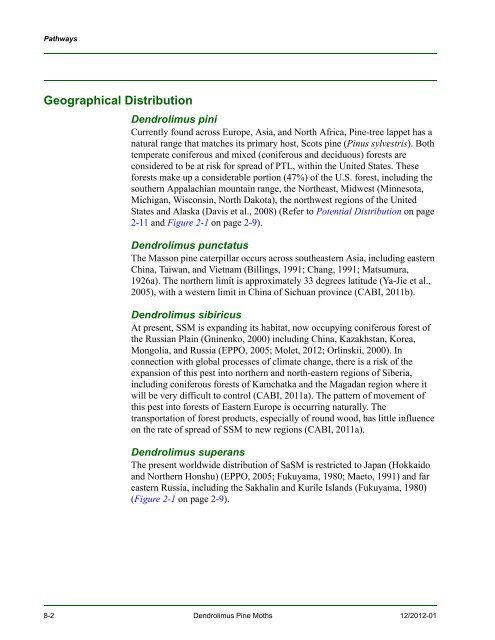New Pest Response Guidelines - aphis - US Department of Agriculture
New Pest Response Guidelines - aphis - US Department of Agriculture
New Pest Response Guidelines - aphis - US Department of Agriculture
Create successful ePaper yourself
Turn your PDF publications into a flip-book with our unique Google optimized e-Paper software.
Pathways<br />
Geographical Distribution<br />
Dendrolimus pini<br />
Currently found across Europe, Asia, and North Africa, Pine-tree lappet has a<br />
natural range that matches its primary host, Scots pine (Pinus sylvestris). Both<br />
temperate coniferous and mixed (coniferous and deciduous) forests are<br />
considered to be at risk for spread <strong>of</strong> PTL, within the United States. These<br />
forests make up a considerable portion (47%) <strong>of</strong> the U.S. forest, including the<br />
southern Appalachian mountain range, the Northeast, Midwest (Minnesota,<br />
Michigan, Wisconsin, North Dakota), the northwest regions <strong>of</strong> the United<br />
States and Alaska (Davis et al., 2008) (Refer to Potential Distribution on page<br />
2-11 and Figure 2-1 on page 2-9).<br />
Dendrolimus punctatus<br />
The Masson pine caterpillar occurs across southeastern Asia, including eastern<br />
China, Taiwan, and Vietnam (Billings, 1991; Chang, 1991; Matsumura,<br />
1926a). The northern limit is approximately 33 degrees latitude (Ya-Jie et al.,<br />
2005), with a western limit in China <strong>of</strong> Sichuan province (CABI, 2011b).<br />
Dendrolimus sibiricus<br />
At present, SSM is expanding its habitat, now occupying coniferous forest <strong>of</strong><br />
the Russian Plain (Gninenko, 2000) including China, Kazakhstan, Korea,<br />
Mongolia, and Russia (EPPO, 2005; Molet, 2012; Orlinskii, 2000). In<br />
connection with global processes <strong>of</strong> climate change, there is a risk <strong>of</strong> the<br />
expansion <strong>of</strong> this pest into northern and north-eastern regions <strong>of</strong> Siberia,<br />
including coniferous forests <strong>of</strong> Kamchatka and the Magadan region where it<br />
will be very difficult to control (CABI, 2011a). The pattern <strong>of</strong> movement <strong>of</strong><br />
this pest into forests <strong>of</strong> Eastern Europe is occurring naturally. The<br />
transportation <strong>of</strong> forest products, especially <strong>of</strong> round wood, has little influence<br />
on the rate <strong>of</strong> spread <strong>of</strong> SSM to new regions (CABI, 2011a).<br />
Dendrolimus superans<br />
The present worldwide distribution <strong>of</strong> SaSM is restricted to Japan (Hokkaido<br />
and Northern Honshu) (EPPO, 2005; Fukuyama, 1980; Maeto, 1991) and far<br />
eastern Russia, including the Sakhalin and Kurile Islands (Fukuyama, 1980)<br />
(Figure 2-1 on page 2-9).<br />
8-2 Dendrolimus Pine Moths 12/2012-01

















